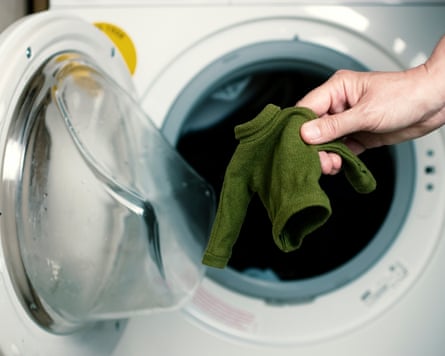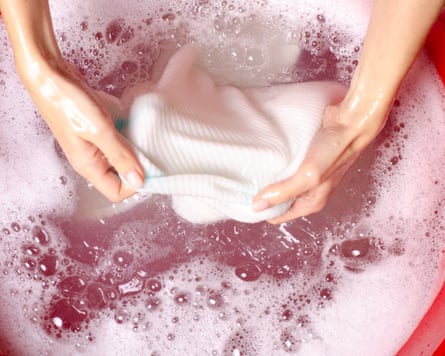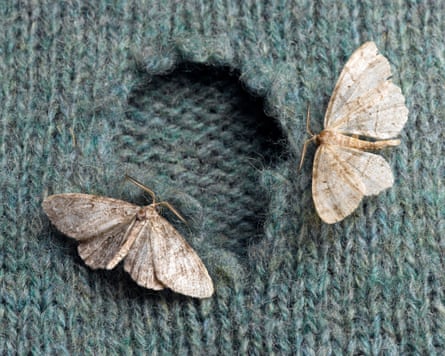Wool is an incredible natural fibre. It has insulating properties, is moisture-wicking and breathable and completely biodegradable. It’s also the most recycled clothing fibre in the world, according to Woolmark, and can be recycled into “new” wool by mechanically shredding and respinning the fibres, or “unknitting” garments and using the wool again (see Rove and iinouiio for details).
Wool also has a reputation for being difficult to care for. But is it? I caught up with experts to find out the best ways to clean and care for your knitwear, so you can keep your roll necks, cardis and cable knits looking beautiful and in use for as many years as possible.
How to look after your knitwear
To wash, or not to wash?

We’ve all shrunk a favourite wool jumper in the wash, so what if the answer was not to wash your knitwear at all? “It just needs a rest in between wears,” says knitwear designer Genevieve Sweeney. “Hanging it outside on a fresh day does it such good and springs it back to life.” Ruth Alice Rands, founder of British knitwear company Herd, agrees: “For knitwear containing any kind of wool, it’s best to wash as little as possible. Wool is naturally rich in lanolin, which means it shrugs off odours and spills, so often an airing will restore it to condition.”
Replace washing with steaming
The British weather doesn’t always allow for hanging your knitwear outside to refresh it, which is where a hand steamer comes into play. “Steaming is a great tool in the maintenance of knitwear and works well for refreshing and returning a garment to shape,” says Rands. “Be sure to always let it dry flat after steaming as per washing.”
“Every wash, no matter how gentle, stresses the fibres,” adds Frej Lewenhaupt, co-founder at clothing care brand Steamery. “Steaming, on the other hand, refreshes the garment instantly. It smooths out creases, removes odours, kills bacteria, and brings the fibres back to life.”
Can you ‘unshrink’ knitwear?
While it is possible to stretch a shrunken knit, the results will depend on how much it has shrunk – it will probably never be quite the same again. “If it’s a little tight or slightly felted, giving the sweater a good steam, to get the fibres relaxed, then giving it a gentle stretch can fix it,” says Sweeney.
For bigger disasters, try soaking it in a bath of baby shampoo before pressing out the water and laying it flat on a towel. “Stretch the knit, pulling down lengthways, then across the width,” she says. “You want to relax the fibres again, so avoid heat and let it air dry. Once dry, give it another good steam and stretch.”
How to remove stains …

If your jumper is stained or really dirty, it may be necessary to wash it. In this case, technique is key. “Spot cleaning with a wool detergent will – almost magically – remove most marks,” says Rands. “If washing is unavoidable, always hand-wash using a gentle detergent and do not agitate it too much. Essentially, heat plus movement equals felting/shrinkage, so move it around in the basin as little as possible and never wring it out.”
Sweeney’s technique involves a once-a-year soak. “Run cool water into the bath – I find even lukewarm water can shrink some wools. Add a little wool wash (or hair shampoo if you don’t have any) and stir it around the water until it has dissolved. Place the knitwear into the bath, ensuring it’s completely covered in water. Gently rub a spot of wool wash into any dirty spots. Leave it for half an hour, then rinse out.”
… and how to dry
Never wring out your wet knitwear. Instead, give it a gentle squeeze before laying it on a towel as flat as possible, on a horizontal hanging rail if you have one. Never – repeat never – put your knitwear in the tumble dryer.
Moths off

Prevention is key, but what actually works to keep moths at bay? Sweeney takes a natural approach with lavender, bay leaves, rosemary and cedar wood shavings. Rands, however, takes no prisoners. “Absolutely foolproof is storing knitwear in airtight boxes (the ones with clips on the side are perfect) and placing [items] in a freezer bag in the freezer for a week at a time over the summer. This removes any chance of any moths surviving.
“The usual cycle for moths is to lay in the spring, and it’s actually when the eggs hatch that they cause the damage, so I cycle my knitwear once through the freezer in the summer (not spring).”
Failing that, the simple act of wearing all your knitwear regularly can help, she says. “Moths don’t like light. Knitwear stored in dark places for extended periods of time is appealing to moths, so ideally it would be regularly worn or given the freezer treatment in the summer to ensure the eggs never hatch.”
The best way to debobble
Well-loved knitwear can start to bobble, especially in areas that rub, such as under the arms. Removing bobbles can freshen up the item, but it’s important to debobble your knitwear carefully. Sweeney uses a cedarwood comb every few months, while Rands gently pulls the bobbles off as and when they appear.
“There is no fixed rule for how often, it depends entirely on how frequently and actively the garment is worn,” says Lewenhaupt. “Some knits might need a quick touch-up every few wears, others only occasionally.”
Embrace visible mending

Creatively and visibly mending knitwear has become increasingly popular as we better understand the value of the fabrics, fibres and clothing we wear, and there are services all over the country that can repair your knitwear. “One of my favourites was a customer who repaired his Vivienne Westwood jumper that was full of moth holes,” says Daisy Harvey, founder of the Loom app, which connects people with skilled creatives who can fix their worn-out items. “He collaborated with an embroiderer on a falling-leaves design. It completely transformed the piece into something even more special.”
For larger holes on areas such as elbows, consider patches, and when your woollen jumper has finally gone beyond the point of salvation, check that it’s a 100% natural fibre, and if so, cut it up and add it to the compost.
For more ideas to help your favourite items last longer:
From beeswax to baby wipes: how to make your leather last a lifetime
‘Glass chopping boards should be illegal’: how to look after your kitchen knives
From cloths to cleaning tablets: how to make your coffee machine last longer
Hannah Rochell is a fashion features journalist who specialises in writing about – and experiencing – slow, comfortable style and living on her Substack Slowette. This involves everything from exclusively wearing flat shoes and investing heavily in elastic-waist linen trousers, to advocating for dehumidifiers instead of tumble dryers and learning to sew

.png) 6 hours ago
5
6 hours ago
5

















































